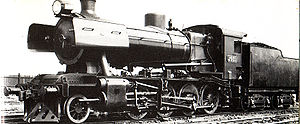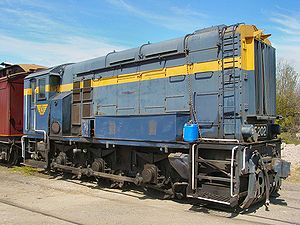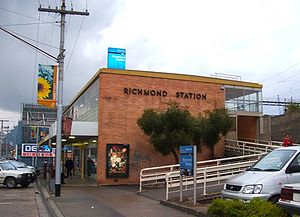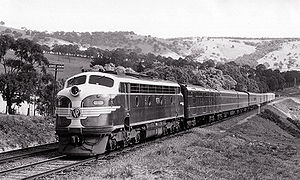.gif)
Operation Phoenix (railway)
Encyclopedia

World War II
World War II, or the Second World War , was a global conflict lasting from 1939 to 1945, involving most of the world's nations—including all of the great powers—eventually forming two opposing military alliances: the Allies and the Axis...
rehabilitation program carried out by the Victorian Railways
Victorian Railways
The Victorian Railways operated railways in the Australian state of Victoria from 1859 to 1983. The first railways in Victoria were private companies, but when these companies failed or defaulted, the Victorian Railways was established to take over their operations...
(VR) in Australia
Australia
Australia , officially the Commonwealth of Australia, is a country in the Southern Hemisphere comprising the mainland of the Australian continent, the island of Tasmania, and numerous smaller islands in the Indian and Pacific Oceans. It is the world's sixth-largest country by total area...
. The program commenced in 1950 and was originally planned to take 10 years and cost £80 million pounds
Australian pound
The pound was the currency of Australia from 1910 until 13 February 1966, when it was replaced by the Australian dollar. It was subdivided into 20 shillings, each of 12 pence.- Earlier Australian currencies :...
. Operation Phoenix was named after the bird from Egyptian mythology
Phoenix (mythology)
The phoenix or phenix is a mythical sacred firebird that can be found in the mythologies of the Arabian, Persians, Greeks, Romans, Egyptians, Chinese, Indian and Phoenicians....
.
Background
The Victorian Railways of the 1930s and 1940s had become run down, with years of economic depression, the war effort, and material shortages resulting in a general decline. At the time it was expected that a railway the size of VR should have been building 25 locomotives, 30 to 40 carriages, and 500 wagons per year, as well as relaying 60 miles of track. In reality VR were only able to build an average of 4 locomotives and 200 wagons per year, and these gains had been counteracted by long overdue scrappings.When World War II hit, the VR had no chance to rebuild, with resources being directed towards the war effort, only patch up work and essential maintenance was possible. Furthermore, passenger travel had been restricted by government, then cut even further due to fuel shortages, with trains taking longer and buffet carriages removed. Despite this, in 1948-49 country passenger business was up 76 percent on that of 1938-39, which were considered the best pre war years, and suburban traffic was up 22 percent. In addition goods traffic was up by 53 percent, with more goods being handled than any of the war years.
After the end of the war, rebuilding work begun in a small way, with new steel, air conditioned carriages built, as well as new sleeping cars for The Overland. However, the growth in patronage was due to a lack of alternate transport, with wartime petrol rationing still in force. Passengers were unimpressed with the service provided, and were looking for someone to blame. In 1949 a review of the Victorian Railways was commissioned by transport minister Kent Hughes, and was carried out by British Railways Chief Executive John Elliot. The report found much to admire in the management and staff, but criticised the run down locomotives, rolling stock, and track and predicted a 'final breakdown of rail transport' in ten years if nothing was done. The ideas of the report were not new, the Victorian Railways had been making plans for modernisation of their operations, but did not have the money or political will to implement them.
Works


- 350 steam and diesel locomotives
- 30 railcars
- 290 steel passenger cars
- 280 suburban passenger carriages
- 9000 goods wagons
- 300 goods vans
Capital works took up the other 43 million, and were planned to cover:
- An underground railway between a new Richmond stationRichmond railway station, MelbourneRichmond is a railway station in Melbourne, Victoria, Australia, located in the suburb of Richmond. It is classed as a Premium Station and is in Metcard Zone 1.-Facilities:...
and North MelbourneNorth Melbourne railway stationNorth Melbourne is a railway station located on the northern edge of the central business district of Melbourne, Australia. The station is the point through which pass the west and north-west bound Craigieburn, Flemington Racecourse, Sydenham, Upfield, Werribee and Williamstown suburban railway...
via the north of the Melbourne CBD. (not realised until the City Loop of the 1980s) - track modernisation, rebuilding, regrading and duplicationDouble trackA double track railway usually involves running one track in each direction, compared to a single track railway where trains in both directions share the same track.- Overview :...
of existing lines - replacement of timber bridges to permit heavier trains
- modernisation of locomotives depots and workshops
- reconstruction and expending Melbourne Yard and associated goods sheds

- 100 steam locomotives
- 17 diesel electric locomotives
- 10 diesel electric shunting locomotives
- 30 self propelled railcars
- 1000 goods wagons
- ElectrificationRailway electrification systemA railway electrification system supplies electrical energy to railway locomotives and multiple units as well as trams so that they can operate without having an on-board prime mover. There are several different electrification systems in use throughout the world...
, regrading and duplicationDouble trackA double track railway usually involves running one track in each direction, compared to a single track railway where trains in both directions share the same track.- Overview :...
of the main Gippsland lineOrbost railway lineThe Orbost railway line is a railway serving the Latrobe Valley and Gippsland regions of Victoria, Australia...
from Dandenong to Traralgon, to cope with demand for Morwell brown coal and to reduce the dependence on New South Wales coalEnergy in VictoriaThe primary energy source for the generation of electricity in the State of Victoria is brown coal - one of the largest contributors to Australia's total domestic greenhouse gas emissions. Brown coal is used for the generation of approximately 85 percent of Victoria's household, commercial and...
. - importation of electric locos
- new substationElectrical substationA substation is a part of an electrical generation, transmission, and distribution system. Substations transform voltage from high to low, or the reverse, or perform any of several other important functions...
s on the suburban railway lines
To ensure the earliest possible delivery, the construction of the steam locomotives, railcars, and half of the wagons was contracted to British firms, with 18 of the railcars had already been completed by 1950. The major components for the mainline diesel electric locomotives were to be imported from the United States, dependent on the allocation of foreign exchange funds
Foreign exchange market
The foreign exchange market is a global, worldwide decentralized financial market for trading currencies. Financial centers around the world function as anchors of trading between a wide range of different types of buyers and sellers around the clock, with the exception of weekends...
from the federal government.
The remainder of the new rolling stock was constructed by the VR's own workshops, including 20 of the 'N class
Victorian Railways N class
The N class was a branch line steam locomotive that ran on Victorian Railways from 1925 to 1966. A development of the successful K class 2-8-0, it was the first VR locomotive class designed for possible conversion from 5 ft 3 in broad gauge to 4 ft 8½ in standard gauge.-History:In 1923, in...
' steam engines, 14 new air conditioned passenger cars, and 2 new suburban trains.
Funding difficulties

Australian pound
The pound was the currency of Australia from 1910 until 13 February 1966, when it was replaced by the Australian dollar. It was subdivided into 20 shillings, each of 12 pence.- Earlier Australian currencies :...
in deficit. Freight rates and passenger fares were increased, but the VR still did not expect to make ends meet. The program of works for 1952-53 was intended to be £12.5 million pounds, and was intended to cover the duplication of the Alamein line between Camberwell and Ashburton, track amplification between Flinders Street and South Yarra, a new Richmond station
Richmond railway station, Melbourne
Richmond is a railway station in Melbourne, Victoria, Australia, located in the suburb of Richmond. It is classed as a Premium Station and is in Metcard Zone 1.-Facilities:...
, importation of 1500 precut houses from England for railway staff, and the purchase of equipment for the use of pulverised brown coal in steam locomotives.
However loans became difficult to negotiate due to money market issues, and so the budget for Operation Phoenix was cut back to £6.8 million pounds. Capital works were slowed, with the loss of employment for many men, and hundreds of thousands of pounds of material were held in storage. Works on the Gippsland electrification was to be completed to Warragul station by 1953, but due to the funding cuts the time line was revised to 1954. 500 of the precut houses were cancelled, the Victorian contribution to joint carriage stock for use on the The Overland was cut to 6 sitting cars, and work at Newport Railway Workshops
Newport Railway Workshops
The Newport Railway Workshops is a facility in the Melbourne suburb of Newport, Victoria, Australia, that builds, maintains and refurbishes railway rollingstock. It is located between the Williamstown and Werribee railway lines.-History:...
building locomotives, carriages and livestock trucks was suspended. Outside rolling stock contractors were also told to slow down, and to defer claims for progress payments until the 1953-54 financial year.
By June 1952 the rolling stock situation was:
- All 50 of the N classVictorian Railways N classThe N class was a branch line steam locomotive that ran on Victorian Railways from 1925 to 1966. A development of the successful K class 2-8-0, it was the first VR locomotive class designed for possible conversion from 5 ft 3 in broad gauge to 4 ft 8½ in standard gauge.-History:In 1923, in...
steam locomotive order in service - 64 of the 70 strong R classVictorian Railways R classThe R class was an express passenger steam locomotive that ran on Australia's Victorian Railways from 1951 to 1974. A long overdue replacement for the 1907-era A2 class 4-6-0, their development and construction was repeatedly delayed due to financial constraints caused by the Great Depression and...
steam locomotive order in service - 60 J classVictorian Railways J classThe J class was a branch line steam locomotive that ran on Victorian Railways from 1954 to 1972. A development of the successful Victorian Railways K class 2-8-0, it was the last new class of steam locomotive introduced on the VR...
steam locomotives on order - 10 F class diesel shunting locomotives delivered
- 26 B class main line diesels on order
- 25 L classVictorian Railways L class (electric)The Victorian Railways L class was a class of mainline electric locomotive that ran on the Victorian Railways and its successor V/Line from 1953 until 1987...
electrics on order - All 30 of the Walker railcars in service
- DERMDiesel Electric railmotor (VR)The Diesel Electric Rail Motor was a railmotor operated by the Victorian Railways of Australia.-History:...
fleet refurbished - 137 goods wagons built by the VR workshops
- 1825 open wagons built by outside contractors
By the end of that year five of the B class diesels and five more R classes were in service.
Outcomes

Dieselisation
Dieselisation or dieselization is a term generally used for the increasingly common use of diesel fuel in vehicles, as opposed to gasoline or steam engines.-Water Transport:...
of the Victorian Railways continued, with the T class
Victorian Railways T class (diesel)
The Victorian Railways T class diesel electric locomotive are a small branch line and shunting unit built by Clyde Engineering . They were the most numerous class of diesel locomotives in the state....
branchline locomotives delivered from 1955. Operation Phoenix was also the peak of capital spending on the Victorian railways, the expenditure during 1950-51 was not exceeded until 1984-85.
See also
- Rail transport in VictoriaRail transport in VictoriaRail transport in Victoria, Australia, is provided by a number of railway operators who operate over the government-owned railway lines. Victorian lines use broad gauge, with the exception of a number of standard gauge freight and interstate lines, a few experimental narrow gauge lines, and...
- Ashworth Improvement PlanAshworth Improvement PlanThe Ashworth Improvement Plan was a report that recommended a number of improvements to be made to the electrified suburban railways of inner city Melbourne, Australia. It was produced in 1940 by a committee headed by John Marmaduke Ashworth, the Victorian Railways Chief Engineer for Way and Works...
- 1969 Melbourne Transportation Plan1969 Melbourne Transportation PlanThe 1969 Melbourne Transportation Plan was a road and rail transport plan for Melbourne, the state capital of Victoria, Australia instituted by Henry Bolte's state government...
- Lonie ReportLonie ReportThe Lonie Report, officially titled Victorian Transport Study, was a thoroughgoing study of freight and passenger transport within the state of Victoria, in Australia...
- New DealNew Deal (railway)The New Deal' for Country Passengers was a timetable introduced on 4 October 1981 in Victoria, Australia that revolutionised the provision of country passenger railway services. 35 little-used passenger stations were closed, rolling stock utilisation improved, and new rolling stock introduced...
- Regional Fast Rail projectRegional Fast Rail projectThe Regional Fast Rail project was a rail transport project of the State Government of Victoria, Australia undertaken between 2000 and 2006 aimed at improving the passenger services on the Victorian regional railway network , specifically to reduce travel times, enhance service frequency and...

